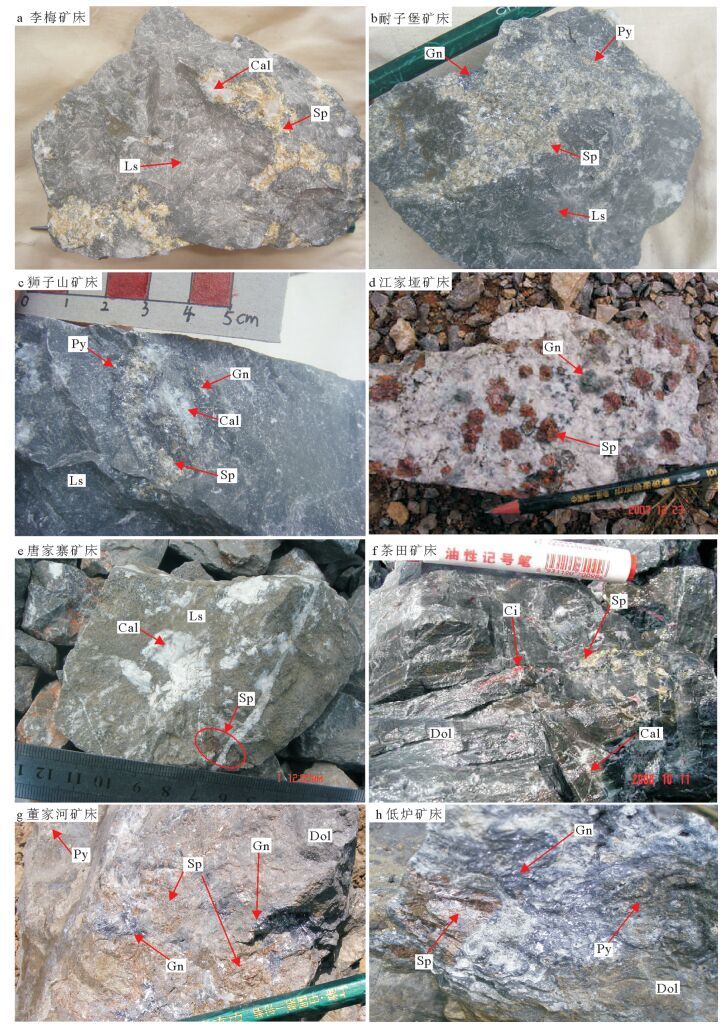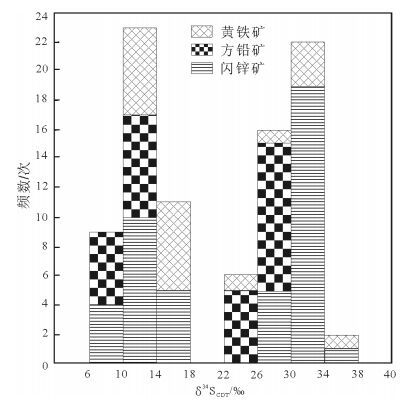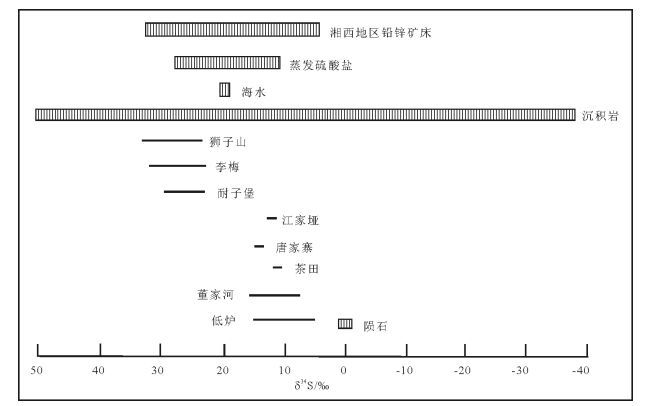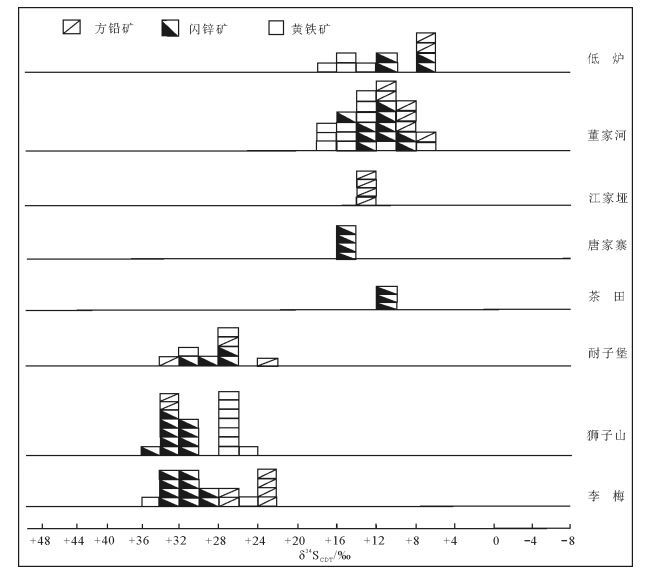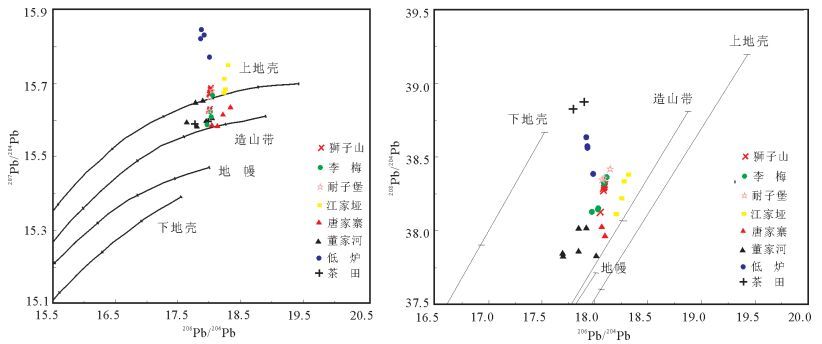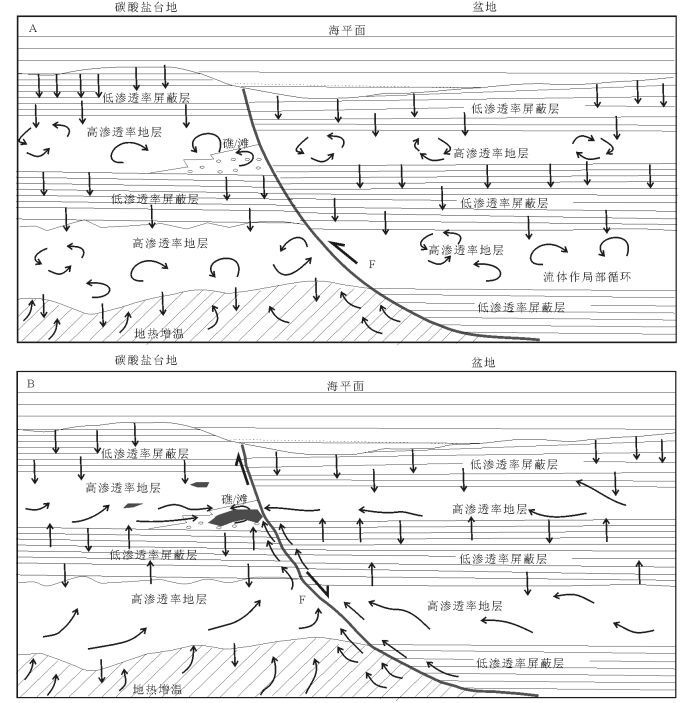Sources of metallogenic materials of lead-zinc deposits in western Hu'nan Province:Evidence from S and Pb isotopes
-
摘要:
湘西地区铅锌矿床位于湘西-鄂西成矿带西南段,具有良好的成矿地质背景和控矿条件,有望成为中国最大的铅锌矿基地。S和Pb同位素组成分析结果表明,湘西地区矿床的δ34S值变化范围为6.30‰~34.66‰,平均值为19.64‰,明显富重硫,具有双塔式分布特征,矿石硫主要来源于容矿地层中的海相硫酸盐类和海水。8个矿床矿石矿物的206Pb/204Pb值范围为17.689~18.295,207Pb/204Pb值变化于15.535~18.848之间,208Pb/204Pb值介于37.294~38.630之间。区内铅锌矿床Pb同位素成分具有造山带和上地壳Pb同位素特征,成矿物质来源于造山带和上地壳的混合作用,铅成因类型为上地壳和地幔因岩浆作用而混合的俯冲铅。提出了湘西地区铅锌矿成矿作用的两阶段演化模式,认为区内铅锌成矿作用经历了成矿流体形成和成矿流体迁移富集2个演化阶段。
Abstract:Located in the southwest of the western Hubei to western Hu'nan metallogentic belt, lead-zinc deposits in western Hu'nan are expected to become the largest lead-zinc deposit basement, with good ore-forming geological background and ore-bear-ing conditions.In this paper, S-Pb isotope compositions of sulfide minerals separated from orebodies in the ore deposits were deter-mined so as to discuss the sources of ore-forming materials.Studies of sulfur and lead isotopic compositions show that the sulfur isoto-pic compositions δ34S in orebodies in western Hu'nan Province are in a wide range of 6.3‰~34.66‰, 19.64‰ on average, with obvi-ous rich heavy sulfur and the characteristics of the distribution of the Twin Towers.Sulfur of the ore mainly came from the marine sul-fate in the ore-bearing formation and seawater.The 206Pb/204Pb, 207Pb/204Pb and 208Pb/204Pb ratios for ore minerals from the eight depos-its are in the ranges of 17.689~18.295, 15.535~18.848 and 37.294~38.630 respectively.As for lead-zinc deposits in this area, lead isoto-pic composition has orogenic belt and upper crust Pb isotopic characteristics, sources of ore-forming materials were from the mixture of orogenic belt and upper crust, lead genetic types are the subduction lead resulting from mixture of upper crust and mantle magma-tism.The authors put forward the lead-zinc ore-forming model of two stages of evolution for deposits of western Hu'nan area.Leadzinc mineralization in the area went through two phases of evolution which included enrichment of ore-forming fluid and migration of ore-forming fluid.
-
Keywords:
- Pb-Zn deposits /
- sulfur isotope /
- lead isotope /
- metallogenic model /
- western Hu'nan Province
-
大兴安岭地区发育广泛花岗岩和火山岩,其岩石成因及构造背景一直是国内外地质学者研究的热点。最新的测年结果显示,这些花岗岩和火山岩主要形成于中生代,少数形成于新元古代和古生代,并对大兴安岭地区岩浆作用的年代学格架和地球化学属性有了一定的认识[1-3],但是由于大兴安岭地区植被覆盖严重,导致部分地区晚中生代岩浆岩的年代学和地球化学数据较缺乏,阻碍了对该区岩浆作用和区域构造演化的深刻认识。
近年来,地质工作者按岩性、岩石组合特征及区域对比,将大兴安岭中部地区晚中生代火山岩划分为南、北两部分,北部主要包括七一牧场组、吉祥峰组、上库力组、伊列克得组,南部主要包括塔木兰沟组、满克头鄂博组、玛尼吐组、白音高老组、梅勒图组,南、北两部分火山岩岩石组合可进行对比,但是对于同一期火山岩不同岩石获得的年龄数据往往具有较大的变化范围,有的甚至相差几十百万年[4-8],表明这种划分方案的合理性仍值得商榷,或许直接用不同岩浆期次来表示不同时代的火山岩比较合理,即用晚侏罗世中基性火山岩、晚侏罗世酸性火山岩、早白垩世中性火山岩、早白垩世酸性火山岩等分别代表不同时代的火山岩。
本次选取大兴安岭中部柴河—蘑菇气地区出露的早白垩世中性火山岩,在野外调查和岩相学研究的基础上,通过岩石学、年代学、岩石地球化学等的系统研究,确定大兴安岭中部柴河—蘑菇气地区早白垩世中性火山岩的岩石成因特点,探讨其反映的区域构造背景。
1. 地质背景及样品描述
大兴安岭位于中亚造山带东段,大地构造位置处于西伯利亚板块和华北板块之间(图 1)[9],其古生代经历了多个微陆块碰撞拼合时期[10-14],构造演化与古亚洲洋的闭合密切相关,中、新生代受太平洋构造域和蒙古-鄂霍茨克构造域的叠加和改造。
![]() 图 1 研究区大地构造位置(据参考文献[9]修改)F1—牡丹江断裂;F2—敦化-密山断裂;F3—伊通-佳木斯断裂;F4—西拉木伦-长春-延吉断裂;F5—贺根山-扎兰屯-黑河断裂;F6—塔源-喜桂图断裂;F7—得尔布干断裂Figure 1. Tectonic map of Chaihe-Moguqi area in central Da Hinggan Mountains
图 1 研究区大地构造位置(据参考文献[9]修改)F1—牡丹江断裂;F2—敦化-密山断裂;F3—伊通-佳木斯断裂;F4—西拉木伦-长春-延吉断裂;F5—贺根山-扎兰屯-黑河断裂;F6—塔源-喜桂图断裂;F7—得尔布干断裂Figure 1. Tectonic map of Chaihe-Moguqi area in central Da Hinggan Mountains柴河—蘑菇气地区位于大兴安岭中部,晚中生代侏罗纪—白垩纪以陆相火山岩地层和陆相碎屑沉积岩地层为主,主要包括中侏罗世万宝组、晚侏罗世塔木兰沟组、木瑞组、满克头鄂博组和早白垩世玛尼吐组、白音高老组、梅勒图组、大磨拐河组。其中早白垩世玛尼吐组以中性火山岩及火山碎屑岩为主,主要分布在天池、蛤蟆沟、柴河、新立屯、蘑菇气、中和、山泉等地区(图 2),主要岩性有灰绿色-灰紫色安山岩(图 3)、英安岩、安山质晶屑凝灰熔岩、凝灰角砾熔岩等。
2. 分析方法
锆石用重液和磁选相结合从粉碎的岩石样品中分选出来,再在双目镜下提纯。锆石被嵌于树脂样靶中并抛光,之后渡上50nm厚的纯金。阴极发光(CL)图像在中国地质科学院北京离子探针中心制成,主要是查明锆石内部结构,以便准确选点。锆石U-Pb定年在天津地质矿产研究所完成。测试仪器为NEPTUNE多接收器电感耦合等离子体质谱仪(MC-ICP-MS)和氟化氩准分子激光剥蚀系统(NEW WAVE 193nm FX)联机[15]。激光剥蚀斑束直径为35μm,激光剥蚀样品的深度为20~40μm。实验中采用氦作为剥蚀物质的载气。锆石年龄计算采用源自澳大利亚Macquarie大学的标准锆石GJ-1作为外标,元素含量采用人工合成玻璃NIST SRM610作为外标[16]。具体实验操作流程见参考文献[17]。样品的同位素比值和元素含量处理采用Glitter(ver4.0)程序计算,普通Pb采用Anderson的3D坐标法校正[18],年龄加权平均值及谐和图采用Isoplot(v. 3.00)[19]绘制。单个测试点的同位素比值和同位素年龄误差为1σ,206Pb/238U年龄加权平均值置信度为95%。
样品的主量和微量元素分析在天津地质矿产研究所和自然资源部哈尔滨矿产资源监督测试中心完成。挑选新鲜未风化样品洗净、烘干后,用玛瑙研钵研磨至200目的粉末,用于主量和微量元素分析。主量元素采用X射线荧光光谱分析(XRF),微量元素的分析采用等离子质谱法(ICP-MS)完成,详细的主量、微量元素分析实验原理和分析步骤见参考文献[20]。
在LA-ICP-MS锆石U-Pb定年的基础上,进行了锆石原位Hf同位素测定工作。锆石原位Hf同位素分析在天津地质矿产研究所完成,测试仪器为NEPTUNE多接收器电感耦合等离子体质谱仪和氟化氩准分子激光剥蚀系统联机,激光束斑直径为50μm。详细的分析方法见参考文献[15]。分析过程中标准锆石GJ-1的176Hf/177Hf值为0.282000 ± 0.000040。用实验测得的176Hf/177Hf和176Lu/177Hf值计算初始176Hf/177Hf值。176Lu的半衰期采用1.865× 10-11/a[21]。计算εHf(t)值时采用的现在的(176Hf/177Hf)DM和(176Lu/177Hf)DM值分别为0.28325和0.0384[22]。Hf模式年龄的计算见参考文献[22-24]。
3. 分析结果
3.1 锆石U-Pb定年
样品Z11-84岩性为安山质角砾凝灰熔岩,共24个锆石分析点,分析结果见表 1。锆石多为短柱状和粒状,少数为长柱状,粒度为50~200μm,长宽比为1:1~3:1。CL图像显示(图 4-a),这些锆石内部具有典型的环带结构,Th/U值为0.65~1.10,指示这些锆石属于岩浆锆石。在锆石U-Pb谐和图(图 4-b)中,样品Z11-84的锆石U-Pb年龄测定数据点全部位于谐和线上及其附近,206Pb/238U年龄加权平均值为139±1Ma(MSWD=0.59),时代为早白垩世,代表了安山质角砾凝灰熔岩的形成年龄。
表 1 研究区早白垩世中性火山岩测年结果Table 1. Data of zircons for the Early Cretaceous intermediate volcanic rocks in study area样品号 岩性 年龄/Ma 采样位置 方法 数据来源 Z11-84 安山质角砾凝灰熔岩 139±1 碾子山北 LA-ICP-MS A P010-5-2 英安岩 141±5 苏河屯 LA-ICP-MS B P9B2-2 安山岩 137±2 青年林场北山 SHRIMP C P11B11-3 角闪玄武安山岩 131±3 河中林场 SHRIMP C TW1 安山岩 133±7 哈布气林场 Rb-Sr D DH2011RZ27 安山岩 141±2 新立屯 LA-ICP-MS E 注:A—本文数据;B—吉林省区域地质矿产调查所提供数据;C—吉林大学刘正宏教授提供数据;D—辽宁省地质矿产调查院提供数据;E—中国地质调查局沈阳地质调查中心提供数据;Z11-84采样点坐标为北纬47°39′51″、东经122°51′34″ 结合笔者收集的年龄数据(表 2)可知,研究区早白垩世中性火山岩的形成年龄介于140~130Ma之间。
表 2 早白垩世中性火山岩测年数据Table 2. Age statistics for the Early Cretaceous intermediate volcanic rocks分析号 Th/10-6 U/10-6 Th/U 同位素比值 年龄/Ma 206Pb/238U 1σ 207Pb/235U 1σ 207Pb/206Pb 1σ 206Pb/238U 1σ 207Pb/235U 1σ 207Pb/206Pb 1σ Z11-84.1 26 33 0.80 0.021 0.0005 0.1767 0.0176 0.0608 0.0053 134 3 165 16 875 447 Z11-84.2 46 42 1.10 0.0222 0.0004 0.1950 0.0161 0.0639 0.0047 141 2 181 15 1120 343 Z11-84.4 27 39 0.69 0.0213 0.0006 0.1506 0.0182 0.0513 0.0033 136 4 142 17 146 598 Z11-84.5 28 33 0.86 0.0217 0.0005 0.1719 0.0189 0.0574 0.0049 138 3 161 18 852 497 Z11-84.6 20 26 0.78 0.0211 0.0006 0.1571 0.0197 0.0539 0.0069 135 4 148 19 181 625 Z11-84.7 41 42 0.98 0.0216 0.0004 0.2040 0.0114 0.0685 0.0048 138 3 189 11 1662 207 Z11-84.8 40 47 0.86 0.0219 0.0003 0.1742 0.0126 0.0576 0.0045 140 2 163 12 514 316 Z11-84.9 33 43 0.78 0.0218 0.0003 0.1635 0.0125 0.0544 0.0042 139 2 154 12 755 322 Z11-84.10 23 31 0.75 0.0219 0.0004 0.1714 0.0103 0.0567 0.0037 140 3 161 10 1997 220 Z11-84.11 27 39 0.70 0.0218 0.0004 0.1474 0.0158 0.0490 0.0049 139 3 140 15 147 587 Z11-84.12 27 32 0.83 0.0216 0.0005 0.2013 0.0115 0.0677 0.0058 138 3 186 11 2164 196 Z11-84.13 40 50 0.79 0.0220 0.0003 0.1660 0.0099 0.0547 0.0030 140 2 156 9 1222 233 Z11-84.14 27 36 0.75 0.0222 0.0004 0.1502 0.0176 0.0491 0.0039 142 2 142 17 152 565 Z11-84.15 25 33 0.76 0.0217 0.0005 0.1671 0.0096 0.0558 0.0055 138 3 157 9 1787 208 Z11-84.16 43 55 0.79 0.0215 0.0005 0.1815 0.0101 0.0611 0.0039 137 3 169 9 2076 194 Z11-84.17 29 41 0.72 0.0219 0.0003 0.1750 0.0125 0.0579 0.0045 140 2 164 12 1447 281 Z11-84.18 48 54 0.87 0.0220 0.0003 0.1899 0.0096 0.0625 0.0042 140 2 177 9 1329 199 Z11-84.19 24 33 0.72 0.0219 0.0005 0.2673 0.0231 0.0887 0.0097 139 3 241 21 1398 365 Z11-84.20 30 39 0.76 0.0215 0.0004 0.1525 0.0147 0.0514 0.0063 137 2 144 14 152 887 Z11-84.21 28 36 0.77 0.0201 0.0008 0.1849 0.0132 0.0668 0.0063 128 5 172 12 1677 271 Z11-84.22 29 40 0.71 0.0220 0.0007 0.1902 0.0174 0.0627 0.0074 140 4 177 16 697 377 Z11-84.23 27 37 0.74 0.0220 0.0004 0.1838 0.0157 0.0607 0.0049 140 3 171 15 1502 339 Z11-84.24 35 53 0.65 0.0220 0.0003 0.1636 0.0087 0.0539 0.0036 140 2 154 8 1034 216 Z11-84.25 42 55 0.77 0.0217 0.0002 0.1806 0.0080 0.0602 0.0025 139 2 169 7 1203 177 3.2 主量和微量元素
研究区早白垩世中性火山岩的主量和微量元素分析结果见表 3。早白垩世中性火山岩SiO2含量在55.1%~69.1%之间,TiO2含量介于0.39%~1.68%之间,Al2O3含量较高,在14.8%~18%之间,TFeO含量介于3.62% ~7.83%之间,MgO含量低,在0.45% ~ 3.74%之间,CaO含量较高,介于1.16%~6.57%之间,Na2O含量在1.73%~4.72%之间,K2O含量在1.66%~ 4.84%之间,整体为一套富钾钠、富铝,贫镁的岩石。在TAS图解(图 5)中,主要落在安山岩、粗面岩(标准矿物石英含量小于20%)内,属亚碱性系列,含铝指数A/CNK为0.80~1.13,属准铝质到弱过铝质岩石;在岩浆系列判别图解(图 6)中,主要落在高钾钙碱性系列。
表 3 早白垩世中性火山岩主量、微量和稀土元素分析结果Table 3. Major, trace and rare earth elements analyses of the Early Cretaceous intermediate volcanic rocks样品号 B1068-1 B2005-2 B2010-1 B2022-1 B2034-1 B2082-2-1 B3007-1 B4063-1 B5049-3 HfP38-2-1 SiO2 58.40 55.40 62.30 68.40 60.90 63.80 69.10 67.00 55.10 60.42 T1O2 0.98 1.68 0.44 0.39 0.76 0.66 0.55 0.58 1.09 0.91 Al2O3 16.90 15.70 15.30 15.70 16.35 16.60 14.80 15.10 16.90 18.00 Fe2O3 3.62 6.65 2.36 1.78 2.29 3.41 2.47 1.99 3.46 2.90 FeO 3.52 1.85 1.20 1.02 2.95 1.12 0.62 2.02 4.70 1.52 MnO 0.10 0.11 0.07 0.04 0.10 0.07 0.06 0.08 0.13 0.11 MgO 2.67 3.15 1.67 0.45 1.96 1.40 0.45 1.38 3.74 1.74 CaO 5.28 6.57 4.06 2.08 5.06 2.74 1.16 2.29 5.78 3.81 Na2O 4.27 3.25 1.73 4.56 3.05 4.50 3.99 3.75 3.37 4.72 K2O 1.66 2.12 3.01 3.80 3.01 3.58 4.84 4.43 2.74 3.36 P2O5 0.27 0.91 0.12 0.08 0.24 0.23 0.12 0.17 0.37 0.37 烧失量 1.78 2.14 7.36 1.09 2.67 1.47 1.29 0.64 1.82 1.94 总计 99.45 99.53 99.62 99.40 99.34 99.58 99.45 99.43 99.20 99.80 σ 2.28 2.33 1.16 2.75 2.05 3.14 2.99 2.79 3.09 3.75 A/CNK 0.92 0.80 1.13 1.02 0.93 1.02 1.06 1.00 0.89 0.98 Na2O+K2O 5.93 5.37 4.74 8.36 6.06 8.08 8.83 8.18 6.11 8.08 Cr 30.20 70.60 17.80 15.90 20.60 16.50 14.20 24.50 30.00 3.21 Rb 24.8 32.4 100 94.9 64.1 86.1 115 76.4 39.4 101.4 Sr 563 807 1480 388 668 571 491 400 671 664.4 Ba 659 953 1190 1020 1020 979 1180 782 664 1065 Th 4.14 3.48 6.02 6.75 4.84 7.32 6.58 8.26 3.6 9.69 U 1.04 0.98 1.39 1.49 1.19 1.95 1.91 2.06 1.18 2.49 Nb 6.76 17.2 6.81 7.34 6.34 9.18 9.25 9.42 6.78 7.69 Ta 0.5 1.1 0.4 0.4 0.41 0.54 0.47 0.64 0.36 0.53 Zr 224 405 235 290 190 247 271 210 158 194.8 Hf 5.89 9.71 6.38 7.91 5.04 6.6 7.24 6.04 4.38 14.91 La 24.2 60.4 26.2 26.3 24.1 32.6 30.6 27.8 19.3 32.62 Ce 50 131 51.7 53.1 48.3 67.6 60.5 55.9 40 62.37 Pr 6.99 16.8 6.6 6.1 5.96 8.1 8 7.21 5.98 7.19 Nd 29.4 68.3 24.5 23.3 23 31.1 32.4 27.3 25.7 29.78 Sm 6.01 12.2 4.44 4.11 4.22 5.51 6.09 4.98 5.4 5.75 Eu 1.59 2.77 1.22 1.21 1.32 1.48 1.56 1.1 1.52 1.96 Gd 4.84 9.27 3.63 3.32 3.62 4.43 4.79 4.08 4.43 4.15 Tb 0.71 1.44 0.56 0.55 0.56 0.67 0.8 0.69 0.78 0.73 Dy 4.15 6.74 3.04 3.03 2.9 3.72 4.76 3.79 4.13 3.67 Ho 0.82 1.19 0.61 0.61 0.56 0.72 0.93 0.72 0.78 0.73 Er 2.31 3.24 1.74 1.78 1.64 2.01 2.66 2 2.28 1.92 Tm 0.35 0.44 0.27 0.28 0.25 0.32 0.4 0.31 0.33 0.3 Yb 2.28 2.76 1.89 1.97 1.62 2.15 2.83 2.06 2.13 2.2 Lu 0.35 0.42 0.31 0.31 0.26 0.34 0.44 0.32 0.32 0.27 Y 22.2 31 16.8 16.6 15.4 20.2 24.9 18.8 21.6 20.3 ∑REE 156.20 347.97 143.51 142.57 133.71 180.95 181.66 157.06 134.68 173.93 LR/HR 7.48 11.43 9.52 9.63 9.37 10.19 7.90 8.90 6.45 9.99 δEu 0.87 0.77 0.90 0.97 1.01 0.89 0.85 0.72 0.92 1.17 注:主量元素含量单位为%,微量和稀土元素含量为10-6 早白垩世中性火山岩微量元素原始地幔标准化蛛网图(图 7-a)显示,样品主要富集大离子亲石元素(如Rb、K、LREE)和Ba、Sr元素,亏损高场强元素(如Ta、Nb、P、Ti),是壳源岩浆或岩浆被地壳物质混染的典型特征。
稀土元素总量(ΣREE)在133.71 × 10-6~ 347.97×10-6之间,平均值为175.22×10-6,轻、重稀土元素比值LREE/HREE在6.45~11.43之间,平均值为9.09,轻、重稀土元素分馏明显,分馏系数(La/Yb)N介于6.50~15.70之间,平均值为9.89。球粒陨石标准化蛛网图(图 7-b)中,均呈右倾配分曲线模式,轻稀土元素富集、重稀土元素亏损,无明显Eu异常,δEu值介于0.72~1.17之间,平均值为0.91。
3.3 锆石原位Hf同位素
在LA-ICP-MS锆石U-Pb定年的基础上,对早白垩世中性火山岩(Z11-84)进行了锆石原位Hf同位素分析,分析结果列于表 4。
表 4 早白垩世中性火山岩锆石原位Hf同位素分析结果Table 4. In situ zircon Hf isotopic compositions of the Early Cretaceous intermediate volcanic rocks分析点 年龄/Ma 176Yb/l77Hf 2σ 176Lu/177Hf 2σ 176Hf/177Hf 2σ 176Hf/177Hf (corr) 2σ εHf(0) εHf(t) 2σ TDM1(Hf)/Ma TDM2(Hf)/Ma fLu/Hf Z11-84.1 134 0.0300 0.0000 0.0008 0.0000 0.282977 0.000019 0.282981 0.000019 7.4 10.26 0.7 382 482 -0.98 Z11-84.2 141 0.0430 0.0001 0.0011 0.0000 0.282859 0.000025 0.282863 0.000025 3.2 6.21 0.9 553 714 -0.97 Z11-84.4 136 0.0446 0.0001 0.0012 0.0000 0.282941 0.000023 0.282944 0.000023 6.1 8.96 0.8 439 556 -0.96 Z11-84.5 138 0.0347 0.0003 0.0010 0.0000 0.282971 0.000024 0.282975 0.000024 7.2 10.12 0.9 393 493 -0.97 Z11-84.6 135 0.0359 0.0001 0.0011 0.0000 0.282975 0.000019 0.282979 0.000019 7.3 10.18 0.7 388 487 -0.97 Z11-84.7 138 0.0458 0.0001 0.0015 0.0000 0.282979 0.000025 0.282983 0.000025 7.5 10.35 0.9 386 479 -0.96 Z11-84.8 140 0.0249 0.0001 0.0007 0.0000 0.282949 0.000023 0.282953 0.000023 6.4 9.40 0.8 421 534 -0.98 Z11-84.9 139 0.0204 0.0000 0.0006 0.0000 0.282965 0.000020 0.282968 0.000020 6.9 9.93 0.7 398 504 -0.98 Z11-84.10 140 0.0224 0.0000 0.0007 0.0000 0.282954 0.000020 0.282958 0.000020 6.6 9.57 0.7 414 525 -0.98 Z11-84.11 139 0.0447 0.0002 0.0012 0.0000 0.282904 0.000023 0.282907 0.000023 4.8 7.73 0.8 492 628 -0.96 Z11-84.12 138 0.0301 0.0001 0.0008 0.0000 0.282932 0.000025 0.282936 0.000025 5.8 8.73 0.9 446 570 -0.98 Z11-84.14 142 0.0297 0.0002 0.0008 0.0000 0.282883 0.000025 0.282886 0.000025 4.0 7.08 0.9 515 666 -0.98 Z11-84.15 138 0.0318 0.0001 0.0008 0.0000 0.282917 0.000032 0.282921 0.000032 5.3 8.23 1.1 467 599 -0.97 Z11-84.16 137 0.0301 0.0001 0.0008 0.0000 0.282994 0.000025 0.282997 0.000025 8.0 10.91 0.9 359 448 -0.98 Z11-84.17 140 0.0411 0.0001 0.0011 0.0000 0.282963 0.000023 0.282967 0.000023 6.9 9.84 0.8 406 510 -0.97 Z11-84.18 140 0.0367 0.0001 0.0010 0.0000 0.282894 0.000030 0.282897 0.000030 4.4 7.42 1.1 503 646 -0.97 Z11-84.19 139 0.0351 0.0001 0.0011 0.0000 0.282991 0.000028 0.282995 0.000028 7.9 10.84 1.0 365 453 -0.97 Z11-84.20 137 0.0341 0.0000 0.0010 0.0000 0.282976 0.000024 0.282980 0.000024 7.4 10.28 0.8 385 483 -0.97 Z11-84.22 140 0.0354 0.0001 0.0010 0.0000 0.282966 0.000028 0.282970 0.000028 7.0 10.00 1.0 399 501 -0.97 碾子山北部早白垩世安山质角砾凝灰岩(Z11-84)中19颗锆石的初始176Hf/177Hf值为0.282863~ 0.282997,εHf(t)值介于+6.21~+10.91之间,其加权平均值为+8.96±0.71,单阶段模式年龄(TDM1)和二阶段模式年龄(TDM2)变化范围分别为359~553Ma和448~714Ma。
由上可见,研究区早白垩世中性火山岩的锆石εHf(t)值均为正值,且具有年轻的二阶段模式年龄(TDM2),二阶段Hf模式年龄集中在新元古代和古生代。在t-εHf(t)图解(图 8)上[27],数据点全部落在球粒陨石演化线和亏损地幔演化线之间,同时落入兴蒙造山带东段范围内,说明早白垩世中性火山岩为地幔来源或来自新增生的年轻地壳物质,与中亚造山带内显生宙火成岩的Hf同位素组成相似[28-29]。
4. 讨论
4.1 早白垩世中性火山岩的岩石成因
研究区早白垩世中性火山岩化学成分显示主要为安山岩、粗面岩等,主量元素总体呈现富钾钠、富铝、贫镁的特征,为准铝质-弱过铝质、高钾钙碱性岩石。研究表明,粗面质火山岩的成因主要包括玄武质岩浆的分异作用[30-32]、玄武质岩浆与流纹质岩浆的混合作用[33-34]和镁铁质地壳熔融[4, 35] 3种观点。研究区早白垩世中性火山岩中铁族元素Cr含量为3.21×10-6~30.20×10-6,远低于地幔橄榄岩源区部分熔融形成的原始玄武质岩浆(Cr=500×10-6~ 600×10-6),且在研究区缺乏同时期的基性岩,因此玄武质岩浆的分异作用很难解释本区大范围分布的中性火山岩。在La-La/Sm图解(图 9)中,早白垩世中性火山岩的La/Sm值与La呈正相关性,表明其为部分熔融形成。
早白垩世中性火山岩富集大离子亲石元素(如Rb、K、LREE)和Ba、Sr元素,亏损高场强元素(如Ta、Nb、P、Ti);富集轻稀土元素(LREE)、亏损重稀土元素(HREE);Ce/Pb值主要介于2.87~4.10之间,平均值为3.36,与地壳平均值3.3相近[36];La/Nb值为2.85~4.24(平均值为3.52),明显高于原始地幔(0.94),接近陆壳的比值(2.2)。这些特征指示,早白垩世中性火山岩应该来源于下地壳岩石的部分熔融。研究区早白垩世安山质角砾凝灰岩(Z11-84)的锆石εHf(t)值均为正值(+6.21~+10.91),且具有年轻的二阶段模式年龄(TDM2=448~714Ma),二阶段Hf模式年龄集中在新元古代和古生代,与大兴安岭中部晚中生代安山岩的Sr-Nd同位素特征(具有低的Sr初始比值和正的εNd(t)值)一致[37],表明早白垩世中性火山岩的岩浆源区主要为地幔或新元古代和古生代期间从地幔新增生的地壳物质。Nb/Ta值集中在13.52~19.68(平均值为16.47),接近球粒陨石和原始地幔的平均值(17.5)[38-39],而高于地壳的Nb/Ta平均值(12~13)[40];Zr/Hf值集中在34.77~ 41.71(平均值为37.40),高于地壳的Zr/Hf平均值(33)[41],与地幔的平均值(37)接近[42],也反映了岩浆源区为从亏损地幔新增生的下地壳物质,所以保留了地幔的部分微量元素的特点。
研究区早白垩世中性火山岩的SiO2含量为55.1%~69.1%,Al2O3为14.8%~18%,MgO为0.45%~ 3.74%,Y为15.4×10-6~31×10-6,Yb为1.62×10-6~ 2.83×10-6,Sr为388×10-6~1480×10-6,无负Eu异常,这些地球化学特征与埃达克岩接近[43-44]。在Yb-Sr/Yb图解(图 10)[45]中,早白垩世中性火山岩部分样品也落入埃达克岩的区域内,结合其K2O的含量为1.66%~4.84%,平均值为3.26%,应为C型埃达克岩,而C型埃达克岩通常认为是玄武质岩浆底侵加厚的地壳底部引起下地壳部分熔融形成的[46]。早白垩世中性火山岩的Nb含量为6.34×10-6~17.20×10-6(平均值为8.68×10-6),Y含量为15.4×10-6~31×10-6(平均值为20.78×10-6),Zr/Y值为7.31~17.47(平均值为11.81),Rb/Sr值为0.04~0.24(平均值为0.13),Ba/Rb值主要集中在10.24~16.85(平均值为12.22),Ba/Sr值为0.80~2.63(平均值为1.60),这些微量元素特征均反映了研究区早白垩世中性火山岩与安第斯地区安山岩和大陆岛弧安山岩相似(表 5),可能与早先俯冲事件带来的流体影响有关[37]。综上所述,研究区早白垩世中性火山岩岩浆源区应为新元古代和古生代期间新增生的下地壳玄武质岩石的部分熔融,并可能受到早先俯冲事件带来的流体的影响。
表 5 早白垩世中性火山岩微量元素特征与不同构造环境安山岩对比[37]Table 5. Trace element characteristics of the Early Cretaceous intermediate volcanic rocks and a comparison with andesites安山岩类 Nb Y Zr/Y Rb/Sr Ba/Rb Ba/Sr 研究区中性火山岩平均值 8.68 20.78 11.81 0.13 12.22 1.60 安第斯安山岩平均值 10.0 15.0 14.6 0.11 10.0 1.05 大陆岛弧安山岩平均值 9.4 22.0 5.4 0.09 8.2 1.16 大洋岛弧低钾安山岩平均值 0.8 25.0 2.2 0.04 18.5 0.61 大洋岛弧其他安山岩平均值 5.0 20.0 4.7 0.08 13.0 0.73 注:Nb和Y的单位为10-6 4.2 早白垩世中性火山岩形成的构造背景
从侏罗纪开始,东北地区的构造格架与其前期历史相比发生了深刻的变化,由东西向构造转变为北东向和北北东向构造,进入环太平洋构造体系和蒙古-鄂霍茨克构造体系的演化阶段[47-48]。对于东北地区大面积晚中生代岩浆岩形成时的构造背景探讨也一直存在争议,主要观点有以下4种:①与地幔柱构造有关[49-51];②与蒙古鄂霍茨克洋的闭合和造山后垮塌有关[52-53];③与古太平洋板块的俯冲作用有关[7, 54];④与蒙古-鄂霍茨克洋闭合和古太平洋俯冲的共同作用有关[5, 55-56]。
研究发现,大兴安岭及其邻区并不存在环状火山岩带,同时中生代火山岩的形成时代范围较大,因此与喷发周期较短的地幔柱构造有关的作用模式很难解释中生代火山岩的时空分布问题[52, 57]。吉黑东部早—中侏罗世(173~190Ma)钙碱性火山岩组合的发现[58-59]和小兴安岭—张广才岭地区同时期双峰式火成岩组合的存在[55, 60-61],表明早侏罗世古太平洋板块向亚洲大陆斜向俯冲,吉黑东部早中侏罗世岩浆作用应该与本次俯冲事件有关。同时,对于吉黑东部火山岩的年代学研究显示,该区尚未发现164~140Ma的火山岩年龄,而145~130Ma的岩浆活动主要分布于松辽盆地以西的大兴安岭及满洲里地区[1, 4, 62-66],表明古太平洋板块的俯冲在中侏罗世晚期—早白垩世早期存在一个间歇期[47],暗示大兴安岭地区中侏罗世—早白垩世早期的岩浆作用与古太平洋板块的俯冲作用无关。早期由于蒙古-鄂霍茨克洋构造演化的研究程度较低,并且通常认为仅存在西伯利亚南缘的北向俯冲[67],而东北地区北缘则处于被动大陆边缘环境,因此很难将大兴安岭地区晚中生代的岩浆活动与蒙古-鄂霍茨克洋的演化联系到一起。近年来,随着蒙古-鄂霍茨克洋缝合带研究程度的提高,尤其是蒙古-鄂霍茨克洋存在向南俯冲的确定[68-70],越来越多的学者认为,大兴安岭地区晚中生代的岩浆活动应与蒙古-鄂霍茨克洋的闭合和造山后垮塌有关[53, 57]。
在(Y+Nb)-Rb构造环境判别图解(图 11)中[71],早白垩世中性火山岩落入后碰撞构造环境。早白垩世早期中性火山岩中部分样品具有C型埃达克岩的特点,表明研究区经历了陆壳加厚的过程。综上所述,大兴安岭中部柴河—蘑菇气地区早白垩世中性火山岩的形成与蒙古-鄂霍茨克洋闭合陆壳加厚之后的岩石圈伸展环境有关。
5. 结论
通过对大兴安岭中部柴河—蘑菇气地区中性火山岩的岩相学、锆石U-Pb年代学、岩石地球化学和锆石原位Hf同位素研究,可以得出如下结论:大兴安岭中部柴河—蘑菇气地区早白垩世中性火山岩的形成年龄介于140~130Ma之间,岩浆源区应为新元古代和古生代期间新增生的下地壳玄武质岩石的部分熔融,并可能受到早先的俯冲事件带来的流体的影响,形成于蒙古-鄂霍茨克洋闭合陆壳加厚之后的岩石圈伸展环境。
-
图 1 湘西地区铅锌矿床区域构造矿产略图(底图据参考文献[2])
1—省界;2—矿田界线;3—向斜及其编号;4—背斜及其编号;5—平移断层及其编号;6—正断层及其编号;7—逆断层及其编号;8—南区斜坡相;9—北区斜坡相;10—铅锌矿床;①—二坪背斜;②—洛塔背斜;③—红岩溪背斜;④—马蹄寨向斜;⑤—盐井背斜;⑥—万坪向斜;⑦—卧云界背斜;⑧—桑植向斜;⑨—八面山向斜;⑩—排碧向斜;⑪ —万岩背斜;⑫ —卡西湖背斜;⑬ —摩天岭背斜;⑭ —凤凰复背斜;F1—二坪断层;F2—洗洛断层;F3—红岩溪断层;F4—盐井断层;F5—大农车断层;F6—花垣-张家界断层;F7—麻栗场断层;F8—古丈-吉首断层;F9—乌巢断层;Ⅰ—洛塔铅锌矿田;Ⅱ—花垣铅锌矿田;Ⅲ—保靖铅锌找矿远景区;Ⅳ—凤凰汞锌找矿远景区
Figure 1. Regional tectonic sketch map of lead-zinc deposits in western Hu'nan Province
图 3 湘西铅锌矿床S同位素对比(底图据参考文献[34])
Figure 3. Sulfur isotope contrast chart of lead-zinc deposits in western Hu'nan Province
图 5 湘西铅锌矿床Pb同位素构造模式投影(底图据参考文献[35])
Figure 5. Lead isotope ratio plot showing geotectonic environment of the source of lead-zinc deposits in western Hu'nan Province
图 6 湘西地区铅锌矿床硫化物Pb同位素Δβ-Δγ成因分类图解(底图据参考文献[36])
1—地幔源铅;2—上地壳铅;3—上地壳与地幔混合的俯冲带铅(3a—岩浆作用;3b—沉积作用);4—化学沉积型铅;5—海底热水作用铅;6—中深变质作用铅;7—深变质下地壳铅;8—造山带铅;9—古老页岩上地壳铅;10—退变质铅
Figure 6. Δβ-Δγ diagram of genetic classification of lead isotopes in sulfides from the lead-zinc deposits in western Hu'nan Province
图 7 湘西地区铅锌矿成矿模式图(底图据参考文献[40])
Figure 7. Map of lead-zinc metallogenic model in western Hu'nan Province
表 1 湘西地区铅锌矿床金属硫化物S同位素组成
Table 1 Sulfur isotopic composition of ore sulfides from the lead-zinc deposits in western Hu'nan Province
矿床 测定矿物 样品数 δ34S/‰ 矿区δ34S/‰ 资料来源 变化范围 平均值 变化范围 离差 平均值 闪锌矿 10 31.30~34.10 32.78 狮子山 方铅矿 8 24.93~27.60 26.74 26.74~32.90 6.16 30.81 本文[5] 黄铁矿 2 32.80~33.00 32.90 闪锌矿 10 28.80~33.13 31.33 李梅 方铅矿 6 22.46~26.37 25.22 25.22~31.33 6.11 28.91 本文[5] 黄铁矿 2 25.70~34.66 30.18 闪锌矿 5 27.06~33.36 29.86 耐子堡 方铅矿 2 23.96~26.59 25.27 25.27~29.86 4.59 28.01 本文 黄铁矿 2 26.87~30.91 28.89 茶田 闪锌矿 3 10.72~11.8 11.09 1.02 11.09 本文 江家垭 方铅矿 4 12.01~13.51 12.63 12.63 0 12.63 本文 唐家寨 闪锌矿 4 14.41~15.22 14.69 14.69 0 14.69 本文 闪锌矿 10 8.44~14.01 11.29 董家河 方铅矿 6 7.30~10.80 9.43 9.43~15.99 6.56 12.23 本文[13] 黄铁矿 10 11.70~17.90 15.99 闪锌矿 5 7.60~12.70 10.02 低炉 方铅矿 2 6.30~6.50 6.40 6.40~14.90 8.50 10.44 本文[13] 黄铁矿 4 13.40~16.90 14.90 表 2 湘西地区铅锌矿床矿石Pb同位素组成及参数
Table 2 Lead isotopic composition and characteristic parameters of ore sulfides from the lead-zinc deposits in western Hu'nan Province
样号 矿石名称 206Pb/204Pb 207Pb/204Pb 208Pb/204Pb t/Ma μ ω Th/U △β △γ 数据来源 方铅矿 18.142 15.681 38.289 456 9.66 38.17 3.82 24.53 39.76 方铅矿 18.115 15.684 38.244 478 9.67 38.16 3.82 24.73 38.54 狮子 方铅矿 18.023 15.658 38.297 513 9.63 38.68 3.89 23.03 39.98 本文 方铅矿 18.099 15.67 38.224 473 9.64 38.03 3.82 23.81 37.99 闪锌矿 18.047 15.622 38.112 454 9.55 37.39 3.79 20.68 34.95 闪锌矿 18.014 15.632 38.242 489 9.58 38.25 3.86 21.33 38.48 耐子堡 闪锌矿 18.075 15.662 38.288 481 9.63 38.37 3.86 23.29 39.73 闪锌矿 18.054 15.63 38.255 459 9.57 38.05 3.85 21.2 38.83 本文 黄铁矿 18.115 15.687 38.35 481 9.67 38.65 3.87 24.92 41.41 闪锌矿 17.999 15.584 38.147 444 9.48 37.46 3.82 18.19 35.9 李梅 闪锌矿 18.037 15.607 38.184 444 9.52 37.62 3.82 19.7 36.91 本文 闪锌矿 18.033 15.622 38.233 464 9.55 38 3.85 20.68 38.24 黄铁矿 18.108 15.676 38.351 474 9.65 38.59 3.87 24.2 41.44 江家垭 方铅矿 18.243 15.692 38.144 398 9.67 37.07 3.71 25.18 35.28 方铅矿 18.295 15.758 38.357 437 9.79 38.31 3.79 29.72 42.82 本文 方铅矿 18.238 15.716 38.325 429 9.71 38.1 3.8 26.93 41.59 方铅矿 18.233 15.688 38.181 400 9.66 37.25 3.73 24.93 36.38 唐家寨 闪锌矿 18.035 15.535 38.019 360 9.38 36.24 3.74 14.72 30.2 闪锌矿 18.123 15.591 37.939 364 9.48 35.93 3.67 18.4 28.21 本文 闪锌矿 18.213 15.621 37.294 232 9.28 32.28 3.53 17.78 25.04 闪锌矿 18.351 15.652 37.486 249 9.21 33.19 3.57 17.21 25.95 黄铁矿 17.821 15.582 37.798 568 9.5 36.95 3.76 19.01 33.51 董家河 黄铁矿 17.698 15.556 37.675 625 9.47 36.89 3.77 17.69 32.74 黄铁矿 17.89 15.653 38.028 600 9.64 38.25 3.84 23.86 41.24 本文[13] 黄铁矿 18.053 15.606 37.814 432 9.52 35.92 3.65 19.75 27.81 黄铁矿 17.728 15.578 37.803 629 9.51 37.49 3.82 19.16 36.42 方铅矿 17.783 15.654 38.021 675 9.66 38.88 3.9 24.46 44.5 方铅矿 17.999 15.778 38.473 661 9.88 40.81 4 32.47 56.29 低炉 方铅矿 17.876 15.83 38.575 798 10.01 41.27 4.12 36.93 65.54 [13] 方铅矿 17.893 15.839 38.589 796 10.02 41.52 4.12 37.51 65.83 闪锌矿 17.894 15.848 38.63 804 10.04 41.63 4.14 38.17 67.37 茶田 方铅矿 17.728 15.599 37.827 652 9.55 37.8 3.83 20.7 38.15 本文 方铅矿 17.912 15.596 37.881 520 9.52 36.92 3.75 19.62 33.6 -
杨绍祥, 劳可通.湘西北铅锌矿床碳氢氧同位素特征及成矿环境分析[J].矿床地质, 2007, 26(3):330-340. http://www.cnki.com.cn/Article/CJFDTOTAL-KCDZ200703009.htm 杨绍祥, 劳可通.湘西北铅锌矿床的地质特征及找矿标志[J].地质通报, 2007, 26(7):899-908. http://dzhtb.cgs.cn/ch/reader/view_abstract.aspx?flag=1&file_no=200707147&journal_id=gbc 付胜云, 彭志刚, 刘红梅.湘西北铅锌矿带成矿地质特征[J].地质勘查, 2006, 3(3):99-103. http://www.cnki.com.cn/Article/CJFDTOTAL-GTDK200603026.htm 周云, 段其发, 唐菊兴, 等.湘西地区铅锌矿的大范围低温流体成矿作用——流体包裹体研究[J].地质与勘探, 2014, 50(3):515-532. http://www.cnki.com.cn/Article/CJFDTOTAL-DZKT201403012.htm 蔡应雄, 杨红梅, 段瑞春, 等.湘西-黔东下寒武统铅锌矿床流体包裹体和硫、铅、碳同位素地球化学特征[J].现代地质, 2014, 28(1):29-41. http://www.cnki.com.cn/Article/CJFDTOTAL-XDDZ201401004.htm 段其发, 曹亮, 曾健康, 等.湘西花垣矿集区狮子山铅锌矿床闪锌矿Rb-Sr定年及地质意义[J].地球科学-中国地质大学学报, 2014, 39(8):977-999. http://www.cnki.com.cn/Article/CJFDTOTAL-DQKX201408004.htm 夏新阶, 舒见闻.湘西李梅锌矿床地质特征及其成因[J].大地构造与成矿学, 1985, 19(3):197-204. http://www.cnki.com.cn/Article/CJFDTOTAL-DGYK503.001.htm 刘宝郡, 王剑.湘西花垣李梅铅锌矿区古热液卡斯特特征及其成因研究[J].大地构造与成矿学, 1990, 14(1):57-67. http://www.cnki.com.cn/Article/CJFDTOTAL-DGYK199001006.htm 舒见闻, 彭国忠.湖南花垣县渔塘铅锌矿床运用地洼学说成矿学找寻富矿的体会[J].大地构造与成矿, 1986, 10(4):359-367. http://www.cnki.com.cn/Article/CJFDTOTAL-DGYK198604013.htm 罗卫, 尹展, 孔令, 等.花垣李梅铅锌矿集区地质特征及矿床成因探讨[J].地质调查与研究, 2009, 33(3):194-202. http://www.cnki.com.cn/Article/CJFDTOTAL-QHWJ200903011.htm 钟九思, 毛昌明.湘西北密西西比河谷型铅锌矿床特征及成矿机制探讨[J].国土资源导刊, 2007, 6(4):52-56. http://www.cnki.com.cn/Article/CJFDTOTAL-GTDK200706041.htm 刘文均, 郑荣才.硫酸盐热化学还原反应与花垣铅锌矿床[J].中国科学(D辑), 2000, 30(5):456-464. http://www.cnki.com.cn/Article/CJFDTOTAL-JDXK200005001.htm 曾勇, 李成君.湘西董家河铅锌矿地质特征及成矿物质来源探讨[J].华南地质与矿产, 2007, 37(3):24-30. http://www.cnki.com.cn/Article/CJFDTOTAL-HNKC200703004.htm 匡文龙, 刘新华, 陈年生, 等.湘西北下光荣矿区铅锌矿床主要地球化学特征[J].地质科学, 2008, 43(3):685-694. http://www.cnki.com.cn/Article/CJFDTOTAL-DZKX200804006.htm 周云, 段其发, 陈毓川, 等.湘西龙山江家垭铅锌矿床石英Rb-Sr同位素测年与示踪研究[J].中国地质, 2015, 42(2):597-606. http://www.cnki.com.cn/Article/CJFDTOTAL-DIZI201502018.htm Ohmoto H. Stable isotope geochemistry of ore deposits[J].Rev. Mineral., 1986, l6(1):491-559.
Hoefs J. Stable Isotope Geochemistry. 4th ed[M]. Berlin:SpringerVerlag, 1997:119-120.
Faure G, Mensing T M. Isotopes:Principles and Applications.3rd ed[M]. New York:John Wiley & Sons, 2005:256-283.
路远发. GeoKit:一个用VBA构建的地球化学工具软件包[J].地球化学, 2004, 33(5):459-464. http://www.cnki.com.cn/Article/CJFDTOTAL-DQHX200405003.htm 张志辉, 张达, 狄永军, 等.安徽铜陵焦冲金-硫矿床S、Pb同位素组成及其指示意义[J].地质通报, 2013, 32(10):1643-1652. doi: 10.3969/j.issn.1671-2552.2013.10.016 胡永嘉, 陆元庆, 梁学东, 等.南震旦、寒武系海相沉积成因重晶石的硫同位素组成及其在地质学上的意义[J].湖南地质, 1986, 5(1):51-56. http://www.cnki.com.cn/Article/CJFDTOTAL-HNDZ198601005.htm 王忠诚, 储雪蕾, 李仲.高δ34S值重晶石矿床的成因解释[J].地质科学, 1993, 28(2):191-192. 徐安武, 梅申福等.鄂西震旦系层控铅锌矿成矿条件研究及找矿耙区预测[M].北京:地质出版社, 1993. Ohmoto H, Rye R O. Isotopes of sulfur and Carbon[C]//Barnes H L.Geochemistry of Hydrothermal Ore Ddeposits(2nd Edition). New York:John Wiley and Sons, 1979:509-567.
张长青. 中国川滇黔交界地区密西西比型(MVT)铅锌矿床成矿模型[D]. 北京: 中国地质科学院博士学位论文, 2008. 李宗发.湘黔边境铅锌矿带硫铅同位素组成特征[J].贵州地质, 1992, 9(3):246-254. http://www.cnki.com.cn/Article/CJFDTOTAL-GZDZ199203006.htm Li R, Chen J, Zhang S, et al. Spatial and temporal variation in carbon and sulfur isotopic compositions of Sinian sedimentary rocks in the Yangtze platform, South China[J]. Precambrian Research, 1999, 97:59-75. doi: 10.1016/S0301-9268(99)00022-4
储雪雷, 李任伟, 张同刚, 等.大塘坡期锰铁矿层中黄铁矿异常高δ34S值的意义[J].矿物岩石地球化学通报, 2001, 20(4):320-322. 李任伟, 张淑坤, 雷加锦, 等.震旦纪地层黄铁矿硫同位素组成时-空变化特征及扬子地块与晚元古超大陆关系的论证[J].地质科学, 1996, 31(3):209-207. http://www.cnki.com.cn/Article/CJFDTOTAL-DZKX603.000.htm 范祖全, 于明舜, 钟太山, 等.湘西贡溪气液沉积型层状重晶石矿床特征及成因分析[J].矿物岩石, 1986, 6(3):65-75. http://www.cnki.com.cn/Article/CJFDTOTAL-KWYS198603009.htm Machel H G, Krouse H R, Sassen R.Products and distingueishing criteria of bacterial and thermochemical sulphate reduction[J]. Applied Geochemitry, 1995, 10:373-389. doi: 10.1016/0883-2927(95)00008-8
Chang Z, Large R R, Maslennikov V. Sulfur isotopes in sedimenthosted orogenic gold deposits:Evidence for an early timing anda seawater sulfur source[J]. Geology, 2008, 36(12):971-974. doi: 10.1130/G25001A.1
郑永飞, 陈江峰.稳定同位素地球化学[M].北京:科学出版社, 2000. 韩吟文, 马振东, 张宏飞, 等.地球化学[M].北京:地质出版社, 2003. Zartman, R. EandDoeB. R. Plumbotectonicsthemodel[J]. Tectonophysics, 1981, 75:135-162. doi: 10.1016/0040-1951(81)90213-4
朱炳泉.地球科学中同位素体系理论与应用——兼论中国大陆壳慢演化[M].北京:科学出版社, 1998. 刘海臣, 朱炳泉.湘西板溪群及冷家溪群的时代研究[J].科学通报, 1994, 39(4):148-150. http://www.cnki.com.cn/Article/CJFDTOTAL-KXTB199402015.htm 梁华英.龙山金锑矿床成矿物质来源研究[J].矿床地质, 1989, 8(4):39-48. http://www.cnki.com.cn/Article/CJFDTOTAL-KCDZ198904004.htm 周云, 段其发, 曹亮, 等.湘西-鄂西地区铅锌矿的大范围低温流体成矿作用[J].高校地质学报, 2014, 20(2):198-212. http://www.cnki.com.cn/Article/CJFDTOTAL-GXDX201402004.htm 段其发. 湘西-鄂西地区震旦系-寒武系层控铅锌矿成矿规律研究[D]. 武汉: 中国地质大学博士学位论文, 2014. 段其发, 曹亮, 周云, 等. 扬子型铅锌矿成矿规律研究与选区评价. 武汉地质调查中心, 2015.




 下载:
下载:











